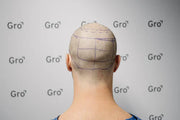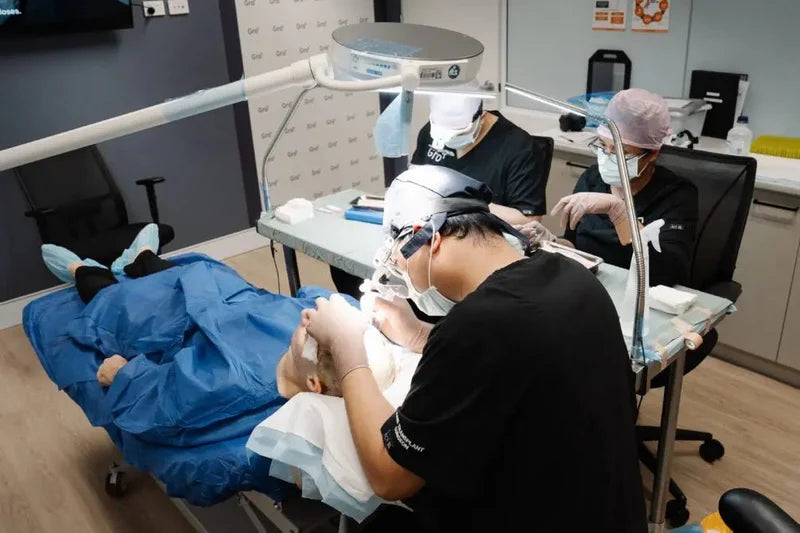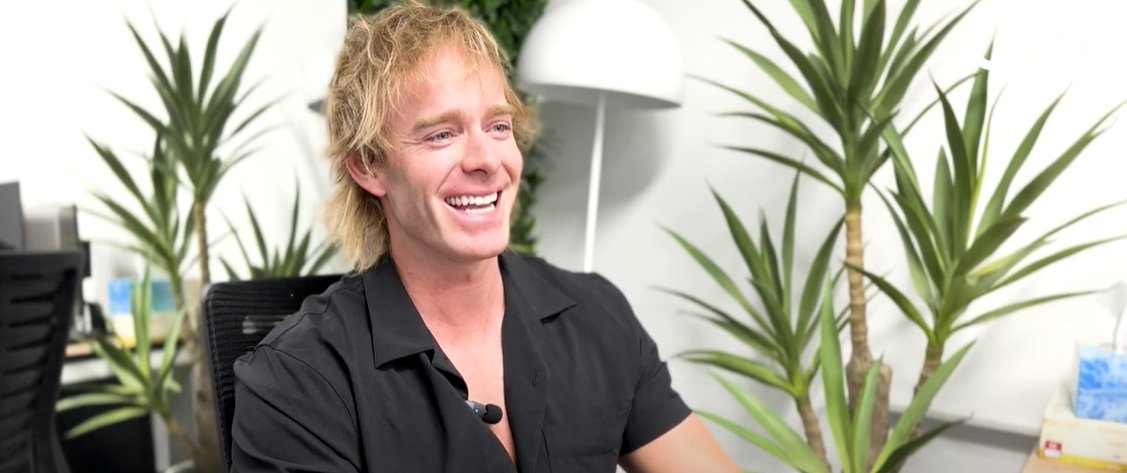PFP - Precise Follicle Placement
Gro is the only hair transplant company to use this technique, why is that? Gro's PFP technique is a top-tier and finely tuned approach that blends micro-FUE and direct implantation methods.
The process involves using a punch tool with a diameter smaller than 1mm to extract individual hair follicles from the donor site one-by-one. Leaving our clients with virtually no visible scarring.With PFP, there is no need to create recipient holes in the treatment area which allows for higher density implantation than traditional FUT or FUE hair transplant methods.
At Gro, our doctors perform this minimally invasive extraction technique from start to finish, ensuring consistent and superior results. The PFP method means our doctors have full control over the depth, direction, and angle of each inserted hair follicle.
Pros of PFP
- Superior Technique: PFP is a top-tier, finely tuned method that combines micro-FUE and direct implantation for exceptional results.
- Minimally Invasive: PFP uses a punch tool with a diameter smaller than 1mm to extract follicles one-by-one, leaving virtually no visible scarring.
- High Density Implantation: No need for recipient holes, allowing for higher density implantation compared to traditional FUT or FUE methods.
- Consistency: Gro's doctors perform the entire process, ensuring consistent and superior results.
- Precise Control: PFP grants full control over the depth, direction, and angle of each hair follicle insertion.
- Exclusive to Gro: Gro clinics are the only ones using the PFP technique, highlighting its uniqueness and effectiveness.
- Natural results: Every Gro doctor undergoes our rigorous Gro Academy training, where they learn our PFP technique and master the art of 'Hairline Design.' We custom-create your new hairline to enhance your features, ensuring it maintains an age-appropriate appearance while looking natural.
- Limited Availability: PFP is only available at Gro clinics, which may limit access for some individuals who are not located near these clinics.
Is PFP Hair Transplant Permanent?
Generally, yes! Most patients start to see results between six months to a year after the procedure.It's important to note that transplanted hair may shed out between the first and third month of recovery before new hairs begin to grow in the transplant location. This shedding phase is normal.
Check out our hair transplant before and afters here!
How Effective is PFP Hair Transplant?
PFP, as a modified version of the FUE method, minimises physical handling, trauma, infection risks, and the possibility of grafts overheating as we use a gro solution to keep the follicles healthy, which can occur with FUE.
Some doctor’s, especially those more accustomed to older methods, may find PFP to be a longer and more challenging procedure. However, those with experience often find it quicker and easier to perform with better outcomes for the client.
Looking for a natural solution for hair growth? Try our hair growth vitamins to prevent DHT damage
FUE - Follicular unit extraction
Follicular Unit Extraction (FUE) is a popular hair transplant method known for its minimally invasive approach. It involves the extraction of individual hair follicles from the donor area, typically at the back or sides of the scalp, using tiny punches. These follicles are then transplanted into the recipient area where hair loss has occurred. FUE is favoured for its relatively quicker recovery and less visible scarring compared to FUT (Follicular Unit Transplantation), which leaves a linear scar. While FUE can yield excellent results, its success also depends on the doctor's skill and the patient's suitability for the procedure.
Pros of FUE Hair Transplant:
- Minimally Invasive: FUE is a minimally invasive procedure, as it involves extracting individual hair follicles without the need for a large incision like the PFP technique.
- Less Visible Scarring: FUE leaves tiny, dot-like scars similar to the PFP technique, scattered across the donor area, which are less noticeable than the linear scar associated with FUT.
- Quick Recovery: Patients typically experience a quicker recovery time compared to FUT, with less postoperative discomfort.
- Suitable for Short Hair: FUE allows patients to keep their hair shorter, as the scars are less visible.
Cons of FUE Hair Transplant:
- Lower Graft Yield: FUE may yield fewer grafts in a single session compared to FUT, which can limit its suitability for extensive hair loss cases.
- Time-Consuming: The individual extraction of follicles in FUE can be time-consuming, leading to longer sessions if the doctor is not used to this technique or not properly trained unlike Gro’s doctors that have to go through an intense training course called Gro Academy.
- Skill-Dependent: The success of FUE heavily depends on the skills of the doctor, and inexperienced doctors or technicians that you normally find abroad and sometimes in AU may yield suboptimal results.
*Both PFP and FUE methods are very safe with extremely high success rates.
FUT - Follicular Unit Transplantation
Follicular Unit Transplantation (FUT) is a hair transplant technique that, while still effective, may not always be considered superior to other methods. FUT involves the removal of a strip of skin from the donor area, resulting in a linear scar that can be visible if the hair is cut very short. This scar can be a drawback for individuals seeking a discreet outcome. Additionally, the procedure typically involves a longer recovery time and more post-operative discomfort compared to minimally invasive methods like FUE. While FUT can provide satisfactory results, advancements in hair transplant technology have led many to explore alternative techniques that offer fewer drawbacks.
Cons of FUT Hair Transplant:
- Visible Linear Scar: FUT involves the removal of a strip of skin from the donor area, leaving a noticeable linear scar on the scalp, which can be challenging to conceal if the hair is cut short.
- Longer Recovery Time: FUT typically requires a longer recovery time compared to minimally invasive methods like FUE and PFP. Patients may experience more post-operative discomfort and swelling.
- Limited Hairstyling Options: The linear scar can restrict hairstyle choices, as it may be visible when hair is cut very short.
- Risk of Nerve Damage: There's a small risk of damaging nerves in the donor area during FUT, which can lead to temporary or permanent numbness.
- Higher Likelihood of Infection: Due to the longer incision and sutures, there may be a slightly higher risk of infection compared to less invasive techniques.
- Potential for Wider Scarring: In some cases, the scar from FUT may widen over time, making it more noticeable.
Pros of FUT Hair Transplant:
- High Graft Yield: FUT typically yields a higher number of grafts in a single session compared to FUE, making it suitable for individuals with extensive hair loss.
- Cost-Effective Per Graft: FUT can be more cost-effective per graft compared to other methods like FUE.
- Suitable for Specific Cases: FUT may be the preferred choice for individuals with certain hair loss patterns and specific donor hair characteristics.
It's important to note that while FUT has its drawbacks, it can still provide effective and lasting results for some patients. The choice of hair transplant method should be based on individual factors and consultation with a qualified doctor.
As with any procedure, transplants have some small risks like bleeding and potential infection. As the new hair begins to grow in, some people suffer folliculitis which is an inflammation or infection of the hair follicles. If you experience any of these, consult with your doctor. Typically, antibiotics and a compress can relieve the issue.
Ready to take the next step? We have clinics all around Australia and New Zealand including Brisbane, Gold Coast, Sydney, Melbourne & Perth.
Why not give us a call on 1300 787 563 to start your hair growth journey.













